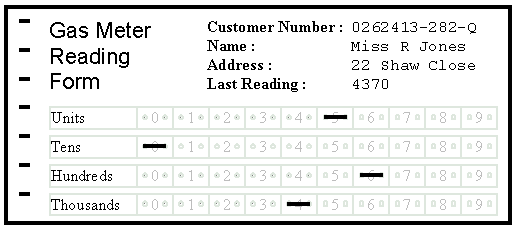
|
Optical mark recognition and optical character recognition are often used together in a turnaround document. A turnaround document is a document which :
Here is a turnaround document that a gas company could use to record meter readings.

The document is printed by a computer. The name, address and customer number of the person that the meter reader should visit is printed on the form. The customer's last meter reading is also included.
The meter reader takes the document and visits the customer's house. He then marks the current meter reading onto the OMR grid on the form. In the example the meter reader has marked the reading as 4605. The form is then returned to the gas company.
At the gas company the form is fed into a special reader. Optical character recognition is used to read the customer's number from the form. Optical mark recognition is used to read the meter reading that has been added. All of the information can be read into the computer automatically. A bill can be produced and posted to the customer without any need for human intervention. Turnaround documents allow cheap, fast input of information into a computer system. There is no possibility of errors occurring because a typist has not transferred the data correctly from the form into the computer.
The customer number could have been printed on the form using a barcode. The disadvantage of this would be that the meter reader could not read the number from the barcode.
The turnaround document does not contain any instructions because the meter reader who fills it in will complete hundreds of similar forms every day. He will have been trained to use the forms so printing instructions on them would simply waste space.
Alternatives to Turnaround Documents
In some industries turnaround documents are being replaced by small handheld computers. For example many gas companies now issue their meter readers with handheld computers. At the start of the day the names and addresses of the customers that the meter reader must visit are downloaded into the computer. As the meter reader visits customers' homes, he types the meter readings into the computer. At the end of the day the readings can be transferred automatically onto the main computer to issue bills. Handheld computers used to enter data into a computer system are known as Portable Data Entry Terminals (PDET).
GCSE ICT Companion 04 - (C) P Meakin 2004